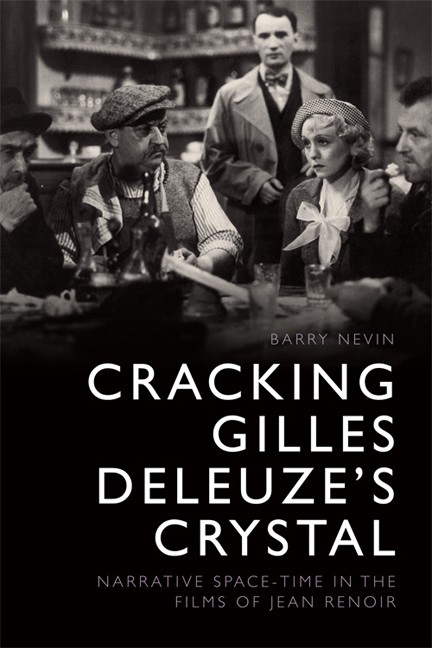Book contents
- Frontmatter
- Contents
- List of Figures
- Notes on Style
- Acknowledgements
- Preface
- Introduction
- 1 Theatrum Mundi: Framing Urban Dynamics in Renoir's Paris
- 2 From Desert to Dreamscape: Viewing Renoir's Rural Landscapes as Spatial Arenas
- 3 Portraying the Future(s) of the Front Populaire
- 4 Renoir's Crises Anti-Réalistes: Framing le Temps Gelé
- Conclusion
- Appendix: Corpus Breakdown
- Notes
- References
- Film Index
- General Subject Index
4 - Renoir's Crises Anti-Réalistes: Framing le Temps Gelé
Published online by Cambridge University Press: 01 May 2021
- Frontmatter
- Contents
- List of Figures
- Notes on Style
- Acknowledgements
- Preface
- Introduction
- 1 Theatrum Mundi: Framing Urban Dynamics in Renoir's Paris
- 2 From Desert to Dreamscape: Viewing Renoir's Rural Landscapes as Spatial Arenas
- 3 Portraying the Future(s) of the Front Populaire
- 4 Renoir's Crises Anti-Réalistes: Framing le Temps Gelé
- Conclusion
- Appendix: Corpus Breakdown
- Notes
- References
- Film Index
- General Subject Index
Summary
Everything was false: false realism, false credit and even false harlots […].
– Gustave Flaubert, 29 April 1871What makes you exist is not the force of your desire […], but the play of the world and seduction; it is the passion of playing and being played, it is the passion of illusion and appearances […].
– Jean Baudrillard, Les Strategies fatalesIntroduction: Seeing Time in the image plane
Prefiguring Deleuze's own emphasis on the theatricality that infuses Renoir's settings, Leo Braudy states:
Renoir's world of theater and his world of nature do not exist in mutually exclusive categories, and in fact more of the unique quality of film can be illuminated if one examines their interaction than if one keeps them totally separate.
Previous chapters have sought to avoid reducing Renoir's worlds to theatres, arguing that a full appreciation of Renoir's mise en scène demands that we examine the counterpoint through which the surcroît de théâtralité and geographical setting (in its physical and social aspects) interact expressively. However, Braudy's and Deleuze's comments are pertinent in the case of Diary of a Chambermaid (1946), The Golden Coach (1952), and Eléna et les hommes (1956): although all three are costume dramas – a genre described by Susan Hayward ‘in its broadest sense as [films] set in an historical period that features characters dressed in costumes pertaining to that era’ – any general sense of geographical place and chronological point in time is secondary to the theatricality foregrounded by various combinations of costume design, set design, camerawork, music, and performance. It is worth noting that the emphatic theatricality that distinguishes each of the three films from Renoir's previous output and the costume-drama genre was not always a deliberate choice on Renoir's part. Years after its release, Renoir stated that ‘Diary of a Chambermaid corresponds with one of my anti-realist crises [crises anti-réalistes].’ Renoir further elaborated:
There are moments when I ask myself if the sole truth is not the inner truth [la vérité intérieure] and if the truth of make-up, of costumes, of appearances, of furniture, the exterior truth [la vérité extérieure], if we really should not neglect it in order to advance a bit more towards this interior truth. Diary of a Chambermaid corresponds with this preoccupation.
- Type
- Chapter
- Information
- Cracking Gilles Deleuze's CrystalNarrative Space-time in the Films of Jean Renoir, pp. 141 - 178Publisher: Edinburgh University PressPrint publication year: 2018



